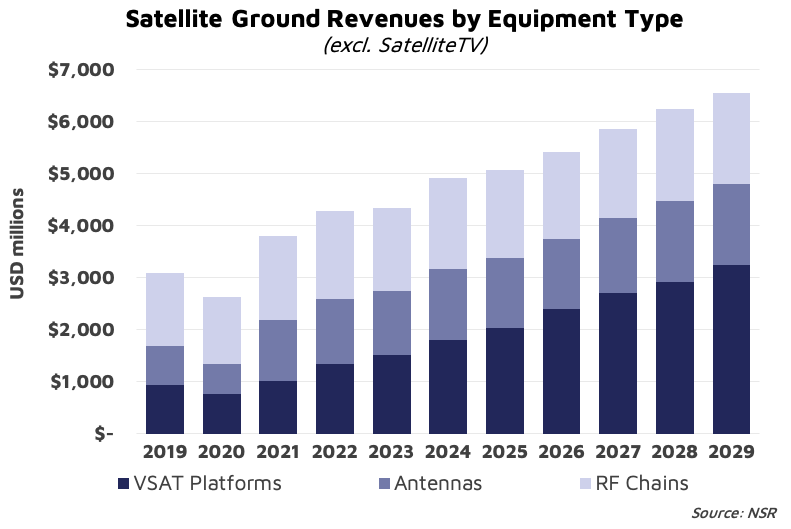Groundwork for COVID-19 Recovery
The Satellite Ground Segment has been one of the hardest-hit steps in the value chain brought about by the pandemic. With many deployments and new deals halted due to lockdowns, equipment could not be shipped, and revenues were not generated. But COVID-19 also accelerated the transformation of the industry, laying the groundwork for solid future growth.

No doubt 2020 was a challenging year for satellite equipment vendors. NSR’s Global Satellite Ground Segment, 5th Edition report estimates revenues were down by -18.6%. However, this is a circumstantial crisis, and the fundamentals in the Satcom Ground Segment continue to be very strong. In fact, NSR forecasts an energetic recovery starting this year and growing at double digit rates through the end of the decade.
Severe Short-Term Impact
No vertical escaped the impact of COVID-19. Unlike other steps in the value chain that could continue generating revenues leveraging on the large installed base, issues such as installers not being able to travel, shipping challenges, factories shutting down, or a sales process still very reliant on in-person meetings and tests made it very hard for equipment vendors to continue their activity, leading to large revenue drops.
Use cases related to Mobility (Aero, Maritime, Land Mobile) obviously suffered the largest drops with revenues declining by 40%-60% in 2020. But even verticals that did generate growth for other steps of the value chain like Backhaul or Consumer Broadband experienced a very challenging Q2 and Q3 period for equipment vendors.
Green Shots
While COVID-19 continues to disrupt our lives, activity is starting to ramp up again. Notably, Cellular Backhaul has experienced a vigorous recovery, somewhat catching up with previous growth trends (Comtech in MEA, Gilat-Hispasat-Altan).
Even applications like Aero do see greater levels of activity (ViaSat-Delta) in anticipation of a ‘generally safe to travel’ COVID-19 status in the second half of 2021. In fact, NSR expects 2021 equipment revenues to surpass 2019’s figures by 10%.
Virtualization, Cloud and 5G: Lessons Learned from Lockdowns
COVID-19 has pushed equipment vendors to adapt their portfolios to this new environment. Remotely managing the installed base was critical during the lockdown period (maintenance, throughput upgrades, interference mitigation). Needless to say, with social distancing, reduced teams and the pressure to catch up with installation schedules, optimizing the commissioning process offered tremendous advantages (quick site set-ups, network performance improvements, ‘zero-touch installations’). Even on the Hub side, where installations typically required the presence of experts from vendors, the process has been transformed to be commissioned remotely.
The industry was already naturally adopting virtualization and the cloud, but the COVID-19 situation undoubtedly accelerated the process. Looking into the future of the industry, these tools will be essential to manage the scale and complexity of VHTS, Software Defined Satellites and constellations, in an ecosystem ruled by the standardized service orchestration defined in 5G.
Bottom Line
Equipment vendors have seen their revenues erode as many deployments have been decelerated and the cadence of new deals slowed due to COVID-19. Having said that, NSR sees revenues returning to growth in 2021.
COVID-19 accelerated many of the underlying technology trends in the industry like the adoption of virtualization and cloudification. These tools are fundamental to meeting the future requirements in terms of scalability, flexibility and integration with the overall telco ecosystem.
NSR supports equipment vendors, service providers, satellite operators, end-users, public agencies and financial institutions in their technology and business strategy assessment and planning. Please contact info@nsr.com for more information.
